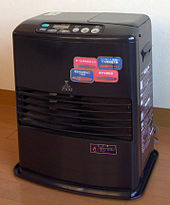Kerosene heater
A circular wick made from fiberglass and/or cotton is integrated into a burner unit mounted above a font (tank) filled with 1-K kerosene.
The kerosene heater is extinguished by fully retracting the wick into a cavity below the burner, which will snuff out the flame.
The unit is fuelled through a conventional side mount cartridge style tank just like other non-vented wick type radiant heaters.
The wick used in a kerosene heater consists of many bundles of fine fibers and, in accordance with the principle behind it, it is designed to provide a large evaporation area.
[1] When filling a kerosene heater, there is an opportunity for the fuel to vaporize and create an odour in the air.
When a kerosene heater is first ignited, it takes a few seconds to a few minutes for the fuel to mix with the air in the perfect ratio for complete combustion.
A common strategy is to light the heater outdoors, on the patio for example, until the fumes dissipate, and then bring it indoors.
An improperly adjusted, fueled, or poorly maintained kerosene heater will release more pollutants, particularly through incomplete combustion.
The open flame poses an explosion risk in environments where flammable vapors may be present, such as in a garage.
The pink "off road" kerosene can be burned in the fiberglass wicked models as well as the Japanese vented heaters.
The Japanese gasification type as well as all the cotton wicked heaters should use clear 1-K. Use of impure fuel can cause extra soot.
A risk of explosion is present with even trace amounts of gasoline/petrol mixed in the fuel, which is why it is illegal in many jurisdictions to dispense gasoline/petrol into unauthorized containers such as kerosene jugs.
Unvented kerosene heaters produce water vapour, creating moisture problems in very tightly sealed homes.
One report states that "paraffin heaters produce 10 pints of water for every gallon of ... gas burnt".
